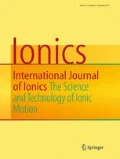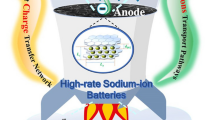Abstract
A facile and easily scalable method for producing disordered carbons as active materials for sodium ion (Na-ion) battery anode has been developed. The materials were synthesized by two-step pyrolysis of microcrystalline cellulose at the final temperature in the range of 950 to 1250 °C, followed by pyrolytic carbon (PC) coating. The effect of heat-treatment temperature (HTT) and PC process on heteroatom content (elemental analysis), porous texture (N2 and CO2 adsorption), and electrochemical performance (coin-type half-cell) was analyzed. Increasing HTT results in remarkable decrease of oxygen content, from 4.4 to 1.4 wt.%, and the surface area accessible for N2 molecules (microporosity), from 502 to 114 m2 g−1, while the carbonization degree, expressed as the H/C atomic ratio and the area probed by CO2 (ultramicropores) are only slightly reduced. Elevating carbonization temperature gradually decreases the irreversible Cirr and increases the reversible Crev capacities in the first charge/discharge cycle. PC coating, applied to 1000 °C, seems to be less effective in improving electrochemical properties than HTT factor despite strong reduction of porosity and surface chemistry. Simple heat treatment at 1200 °C seems to be optimal to produce anodic material with the best electrochemical performance in a wide range of current load: coulombic efficiency of 0.78 and Crev of 306 or 261 mAh g−1 at 20 or 500 mA g−1, respectively.







Similar content being viewed by others
References
Endo M, Kim YJ, Park KC (2010) Advanced battery applications of carbons. In: Beguin F, Frackowiak E (eds) Carbons for electrochemical energy storage and conversion systems. CRC Press, London, pp 469–507
Yabuuchi N, Komaba S (2014) Recent research progress on iron- and manganese-based positive electrode materials for rechargeable sodium batteries. Sci Technol Adv Mater 15:043501
Zaghib K, Trottier J, Hovington P, Brochu F, Guerfi A, Mauger A, Julien CM (2011) Characterization of Na-based phosphate as electrode materials for electrochemical cells. J Power Sources 196:9612–9617
Stevens DA, Dahn JR (2001) The mechanisms of lithium and sodium insertion in carbon materials. J Electrochem Soc 148:A803–A811
Doeff MM, Ma Y, Visco SJ, De Jonghe LC (1993) Electrochemical insertion of sodium into carbon. J Electrochem Soc 140:L169–L170
Stevens DA, Dahn JR (2000) High capacity anode materials for rechargeable sodium-ion batteries. J Electrochem Soc 147:1271–1273
Zheng Y, Dahn JR (1999) Applications of carbon in lithium-ion batteries. In: Burchell TD (ed) Carbon materials for advanced technologies. Pergamon, Amsterdam, pp 341–387
Buiel E, Dahn JR (1999) Li-insertion in hard carbon anode materials for Li-ion batteries. Electrochim Acta 45:121–130
Beguin F, Chevalier F, Vix C, Saadallah S, Rouzaud JN, Frackowiak E (2004) A better understanding of the irreversible lithium insertion mechanism in disordered carbons. J Phys Chem Solids 65:217–211
Yang J, Zhou X, Li J, Zou Y, Tang J (2012) Study on nano-porous hard carbons as anode materials for lithium ion batteries. Mat. Chem Phys 135:445–450
Chen X, Kierzek K, Jiang Z, Chen H, Tang T, Wojtoniszak M, Kalenczuk RJ, Chu PK, Borowiak-Palen E (2011) Synthesis, growth mechanism, and electrochemical properties of hollow mesoporous carbon spheres with controlled diameter. J Phys Chem C 115:17717–17724
Rouzaud JN, Clinard C (2002) Quantittaive high-resolution transmission electron microscopy: a promising tool for carbon material characterization. Fuel Proc Technol 77–78:229–235
Letellier M, Chevalier F, Clinard C, Frackowiak E, Rouzaud JN, Beguin F, Morcrette M, Tarascon JM (2003) The first in situ 7Li nuclear magnetic resonance study of lithium insertion in hard carbon anode materials for Li-ion batteries. J Chem Phys 118:6038–6045
Fujimoto H, Mabuchi A, Tokumitsu K, Chonnasami N, Kasuh T (2011) 7Li nuclear magnetic resonance studies of hard carbon and graphite/hard carbon hybrid anode for Li ion battery. J Power Sources 196:1365–1370
Buiel E, Dahn JR (1998) Reduction of the irreversible capacity in hard-carbon anode materials prepared from sucrose for Li-ion batteries. J Electrochem Soc 145:1977–1981
Isaev I, Salitra G, Soffer A, Cohen YS, Aurbach D, Fischer J (2003) A new approach for the preparation of anodes for Li-ion batteries based on activated hard carbon cloth with pore design. J Power Sources 119:28–33
Ohzawa Y, Yamanaka Y, Naga K, Nakajima T (2005) Pyrocarbon-coating on powdery hard-carbon using chemical vapor infiltration and its electrochemical characteristics. J Power Sources 146:125–128
Wu Y, Wan C, Yiang C, Fang S, Jiang Y (1999) Mechanism of lithium storage in low temperature carbon. Carbon 37:1901–1908
Hasegawa G, Kanamori K, Kannari N, Ozaki J-I, Nakanishi K, Abe T (2016) Studies on electrochemical sodium storage into hard carbons with binder-free monolithic electrodes. J Power Sources 318:41–48
Kierzek K, Piotrowska A, Machnikowski J (2015) Cellulose-based carbon—a potential anode material for lithium-ion battery. J Phys Chem Solids 86:215–222
Neimark AV, Lin Y, Ravikovitch PI, Thommes M (2009) Quenched solid density functional theory and pore size analysis of micro-mesoporous carbon. Carbon 47:1628–1617
Dubinin MM (1989) Fundamentals of the theory of adsorption in micropores of carbon adsorbents: characteristics of their adsorption properties and microporous structures. Carbon 27:467–457
Stoeckli F, López-Ramón MV, Hugi-Cleary D, Guillot A (2001) Micropore sizes in activated carbons determined from the Dubinin-Radushkevich equation. Carbon 39:1115–1116
Buiel E, George AE, Dahn JR (1998) On the reduction of lithium insertion capacity in hard-carbon anode materials with increasing heat-treatment temperature. J Electrochem Soc 145:2252–2257
Kotlensky WV (1973) Deposition of pyrolytic carbon in porous solids. In: Walker PL Jr, Thrower PA (eds) Chemistry and Physics of Carbon. Marcel Dekker Inc., New York, pp 173–262
Mochida I, C-H K, Korai Y (2001) Anodic performance and insertion mechanism of hard carbons prepared from synthetic isotropic pitches. Carbon 39:399–410
Chevallier F, Letellier M, Morcrette M, Tarascon J-M, Frackowiak E, Rouzaud J-N, Béguin F (2003) In situ 7Li-nuclear magnetic resonance observation of reversible lithium insertion into disordered carbons. Electrochem Solid-State Lett 6:A225–A228
Zheng T, Zhong Q, Dahn JR (1995) High-capacity carbons prepared from phenolic resin for anodes of lithium-ion batteries. J Electrochem Soc 142:L211–L214
Liu Y, Xue JS, Zheng T, Dahn JR (1996) Mechanism of lithium insertion in hard carbons prepared by pyrolysis of epoxy resins. Carbon 34:193–200
Kierzek K, Machnikowski J, Béguin F (2015) Towards the realistic silicon/carbon composite for Li-ion secondary battery anode. J Appl Electrochem 45:1–10
Chevrier VL, Ceder G (2011) Challenges for Na-ion negative electrodes. J Electrochem Soc 158:A1011–A1014
Acknowledgements
The research was financed by a statutory activity subsidy from the Polish Ministry of Science and Higher Education for the Faculty of Chemistry of Wrocław University of Technology.
Author information
Authors and Affiliations
Corresponding author
Electronic supplementary material
ESM 1
(DOC 1394 kb)
Rights and permissions
About this article
Cite this article
Kierzek, K., Machnikowski, J. Cellulose-derived carbons as a high performance anodic material for Na-ion battery. Ionics 24, 1313–1320 (2018). https://doi.org/10.1007/s11581-017-2298-0
Received:
Revised:
Accepted:
Published:
Issue Date:
DOI: https://doi.org/10.1007/s11581-017-2298-0




